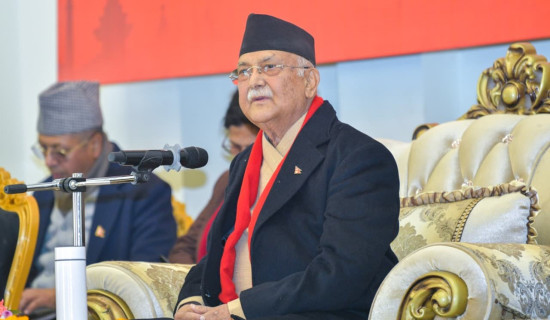- Saturday, 10 January 2026
Address Landless Squatters' Problems
The sukumbasi (landless squatter) problem is one of the burning problems besetting the Kathmandu Valley. The sukumbasis are occupying government land along the banks of the Bagmati and other rivers and elsewhere. Several attempts have been made to remove them but to no avail. It is said that many of the sukumbasis are people with connections with leaders and other influential people. Some months ago, the Kathmandu Metropolitan City (KMC) tried to demolish the sukumbasi settlements along the banks of the Bagmati River. A clash erupted between the KMC police force and the sukumbasis. At long last, the KMC force had to retreat. Since then, no attempt has been made to remove the sukumbasis.
Supreme Court's Verdict
In the meantime, the Supreme Court’s verdict on mitigating flooding and protecting river systems came out. As per the verdict, an additional 20-metre buffer zone will have to be maintained on either side of a river. This means a river which already has a 20-metre buffer zone will have a 40-metre buffer zone. It may be noted that on Mangsir 1, 2065 BS, the government fixed standards for creating buffer zones along the rivers in the Kathmandu Valley. As per the standards, the Bagmati, Bishnumati and Manohar rivers have a 20-metre buffer zone on either side. If the Supreme Court’s verdict is to be implemented, a 40-metre buffer zone will have to be created on both sides of these rivers.
On the basis of the verdict, the KMC has announced that it will implement the verdict strictly and manage the sukumbasi settlements. The KMC is planning to relocate the genuine sukumbasis to the apartments built at Ichangu. But the sukumbasis are not willing to move to the apartments. Ichangu lies in the Nagarjun Municipality and is across the Ring Road. The sukumbasis are demanding that they be provided with plots of land in Kathmandu itself. As per the verdict, alternative arrangements will be made to relocate the sukumbasis who refuse to move to Ichangu elsewhere. This exposes the intentions of the sukumbasis: they want to live in Kathmandu itself.
Almost all of the sukumbasis are from outside the Kathmandu Valley. They have migrated to the Valley and occupied government land illegally. It is reported that some of the sukumbais have their own buildings and the others, who are rich, have their children in foreign countries. It is also reported that some of the sukumbais have given the illegally occupied land to others on rent. So it is essential to separate fake from genuine sukumbasis. The government should come up with a strict policy of penalising the fake sukumbasis and helping out the genuine ones. For example, those who are well-to-do or have buildings should be heavily fined so that such crooked people cannot raise their ugly heads in the future.
As far as the implications of the verdict are concerned, there is more to the verdict than meets the eye. The verdict aims at protecting river systems, which get into peril whenever there is heavy rain. As enunciated in the verdict, the High-Powered Commission for the Integrated Development of the Bagmati Civilisation is assigned the task of implementing the verdict. The verdict has instructed the government to set up a powerful body to ensure that the verdict is effectively brought into force with a focus on balancing river conservation with the needs and rights of the people affected. The body will include local leaders, city mayors and other stakeholders.
There are many structures built along the banks of rivers. As the rivers dried up in the past, the government encroached upon the land and built roads. And buildings were allowed to sprout along the roads. When this was done, the government did not pay attention to the consequences that would emerge in the future. Now the people living along the riverbanks are suffering consequences. An adequate setback from the riverbanks and a good system of drainage may help reduce flooding and inundation in the future. As per the verdict, the existing structures lying within the revised buffer zones – government, public and memorial buildings – should be demolished and the residents concerned should be properly compensated. And no-construction zones should be established in the buffer zones where there are no structures.
Flooding and inundation
Earlier, there was a 4-metre buffer zone, which was later increased to 10 meters and up to 20 meters in 2065. The flow of rivers is high during the monsoon season. The havoc being wreaked by the monsoons now shows that the existing standards are not enough to prevent flooding and inundation. Although the KMC is determined to implement the verdict at any cost, it is not so easy. Implementing the verdict at the cost of the residents concerned will not be judicious. The government will have to bear a high cost by way of compensations. Dehousing the residents in the name of enforcing the verdict will be a great injustice to them. First of all, alternative accommodation should be in place for them.
There are other alternatives for controlling floods in the Kathmandu Valley. Flood management strategies should be adopted to control flooding. Embankments or dams should be built along the banks of the rivers. The depth of the rivers can be increased. For this, the rivers should be cleaned. Throwing garbage, old cloth and other materials into the rivers should be completely banned. The drainage systems should be improved. But all this depends on the will of the government.
Anyway, the local governments are studying the text of the verdict. Thereafter, it will be discussed at the Valley Mayors’ Forum. The Forum is expected to come up with appropriate strategies aimed at preventing flooding and inundation on the one hand and doing justice to the people affected on the other hand.
(Maharjan has been regularly writing on contemporary issues for this daily since 2000.)

















